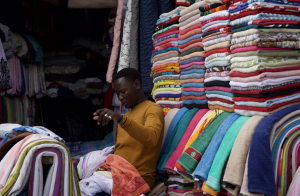New report urges governments to back the coexistence of used clothing imports and local manufacturing for African growth
New report forecasts 15-year roadmap for Kenyan growth, showing that Mitumba and domestic textile manufacturing are complementary sources of growth.
This evidence-based report is the most comprehensive study of Kenya’s apparel sector to date, concluding that the country’s second-hand clothing trade (Mitumba) and its local apparel manufacturing can coexist and complement each other. Far from being competitors, the two sectors serve different markets. While Kenyan households are hybrid consumers, buying both new and used clothes, as incomes rise, the consumption of used clothes decreases. By 2037, a Kenyan’s average income is expected to double, leading to robust market demand for both sectors as people look to spend more money on clothes.
An apparel sector comprising used clothing imports and local production can drive inclusive economic growth, job creation, and sustainability in line with Kenya’s Vision 2030 and the African Union’s Agenda 2063. But this relies on a supportive policy regime that boosts both used clothing imports and local production.
The study offers a 15-year roadmap for strengthening Kenya’s apparel and footwear industry using advanced economic modelling, consumer survey data, and policy analysis. It highlights that Mitumba is not a threat to Kenya’s industrial ambitions but a vital part of a diversified economy that can work not just in Kenya but across the African continent.
“We believe that the future of the apparel sector is about strategic coexistence, not competition,” said Teresia Wairimu Njenga, Chairperson of MCAK. “The report offers compelling evidence that second-hand clothing isn’t a barrier to the textile industry’s growth – it’s part of the solution. We can ensure that low-income families can afford quality clothes while expanding local manufacturing. With smart, inclusive policies, both sectors will thrive, fulfilling the promise of Vision 2030 and Agenda 2063.”
The report’s findings underscore the significant contributions of the Mitumba trade and its complementary role alongside local manufacturing:
Jobs and Revenue: In 2022, Kenya imported approximately 177,000 tonnes of second-hand clothing, supporting around 2 million livelihoods (many held by women and youth) and generating about Ksh 12 billion in annual tax revenue (≈USD 100 million).
Environmental Benefits: The reuse and upcycling of garments through the Mitumba market significantly reduce textile waste and lower the fashion industry's environmental footprint. By keeping usable clothing in circulation instead of landfills, the second-hand trade advances circular economy goals and aligns with global sustainability efforts to curb waste and pollution.
Lead researcher for the report and CEO of the Institute of Economic Affairs, Kenya, Kwame Owino, said:
“Our findings make one thing clear: citizens and economies can gain the most when Mitumba and local manufacturing grow together. When we remove needless barriers, the combined strength of these sectors can create more jobs, more consumer choice, and more sustainable growth than if we stifle one in favour of the other. It’s a win-win for our economy and hardworking families relying on affordable clothing. This is about smart policymaking grounded in evidence – leveraging the strengths of each segment rather than picking winners and losers.”
Policy Recommendations: To achieve this balanced growth, the report provides a policy roadmap for Kenya’s government. Key recommendations to allow both Mitumba and domestic production to thrive include:
- Harmonise import rules and enforce quality standards for new and used clothing.
- Support local manufacturers through tax breaks and skills training.
- Promote eco-friendly practices across the industry.
These evidence-based recommendations aimed at policymakers help to chart a path to uniquely African growth in the textiles industry, as countries strive to meet the African Union’s Agenda 2063 for sustainable and inclusive economic transformation. The report emphasises that supportive, well-informed policies, rather than punitive measures, will enable the apparel sector to be a driver of inclusive growth and social welfare.
Mitumba Consortium Association of Kenya
MCAK
mcak|mitumbaassociation.org| |mcak|mitumbaassociation.org
Legal Disclaimer:
EIN Presswire provides this news content "as is" without warranty of any kind. We do not accept any responsibility or liability for the accuracy, content, images, videos, licenses, completeness, legality, or reliability of the information contained in this article. If you have any complaints or copyright issues related to this article, kindly contact the author above.
The Automotive Experience Alliance Advances Strategies to Align Elevate and Future-Proof Auto Shows
ENSESO4Food and Primabis Partner to Deliver FSMA 204 Traceability in Latin America
Grand Opening of Simply You Medical Spa in Visalia, CA Brings 'Botox and Bubbles' to the Central Valley
Więcej ważnych informacji
 Jedynka Newserii
Jedynka Newserii

 Jedynka Newserii
Jedynka Newserii

Konsument

Polacy nie korzystają z hossy trwającej na warszawskiej giełdzie. Na wzrostach zarabiają głównie inwestorzy zagraniczni
Od października 2022 roku na rynkach akcji trwa hossa, nie omija ona także warszawskiej giełdy. Mimo to inwestorzy indywidualni odpowiadają zaledwie za kilkanaście procent inwestycji, a o wzrostach decyduje i na nich zarabia głównie kapitał z zagranicy. Widać to również po napływach i odpływach do i z funduszy inwestycyjnych. Zdaniem Tomasza Koraba, prezesa EQUES Investment TFI, do przekonania Polaków do inwestowania na rodzimej giełdzie potrzeba zysków z akcji, informacji o tych zyskach docierającej do konsumentów oraz czasu.
Polityka
Obowiązek zapełniania magazynów gazu w UE przed sezonem zimowym ma zapewnić bezpieczeństwo dostaw. Wpłynie też na stabilizację cen

Unia Europejska przedłuży przepisy z 2022 roku dotyczące magazynowania gazu. Będą one obowiązywać do końca 2027 roku. Zobowiązują one państwa członkowskie do osiągnięcia określonego poziomu zapełnienia magazynów gazu przed sezonem zimowym. Magazyny gazu pokrywają 30 proc. zapotrzebowania Unii Europejskiej na niego w miesiącach zimowych. Nowe unijne przepisy mają zapewnić stabilne i przystępne cenowo dostawy.
Infrastruktura
Gminy zwlekają z uchwaleniem planów ogólnych zagospodarowania przestrzennego. Może to spowodować przesunięcie terminu ich wejścia w życie

Reforma systemu planowania i zagospodarowania przestrzennego rozpoczęła się we wrześniu 2023 roku wraz z wejściem w życie większości przepisów nowelizacji ustawy z 27 marca 2003 roku. Uwzględniono w niej plany ogólne gminy (POG) – nowe dokumenty planistyczne, za których przygotowanie mają odpowiadać samorządy. Rada Ministrów w kwietniu br. uchwaliła jednak ustawę o zmianie ustawy z 7 lipca 2023 roku, a jej celem jest zmiana terminu obowiązywania studiów uwarunkowań i kierunków zagospodarowania przestrzennego gmin na 30 czerwca 2026 roku. Wskazana data może nie być ostateczna z uwagi na to, że żadna z gmin nie uchwaliła jeszcze POG.
Partner serwisu
Szkolenia

Akademia Newserii
Akademia Newserii to projekt, w ramach którego najlepsi polscy dziennikarze biznesowi, giełdowi oraz lifestylowi, a także szkoleniowcy z wieloletnim doświadczeniem dzielą się swoją wiedzą nt. pracy z mediami.











.gif)

 |
| |
| |
|